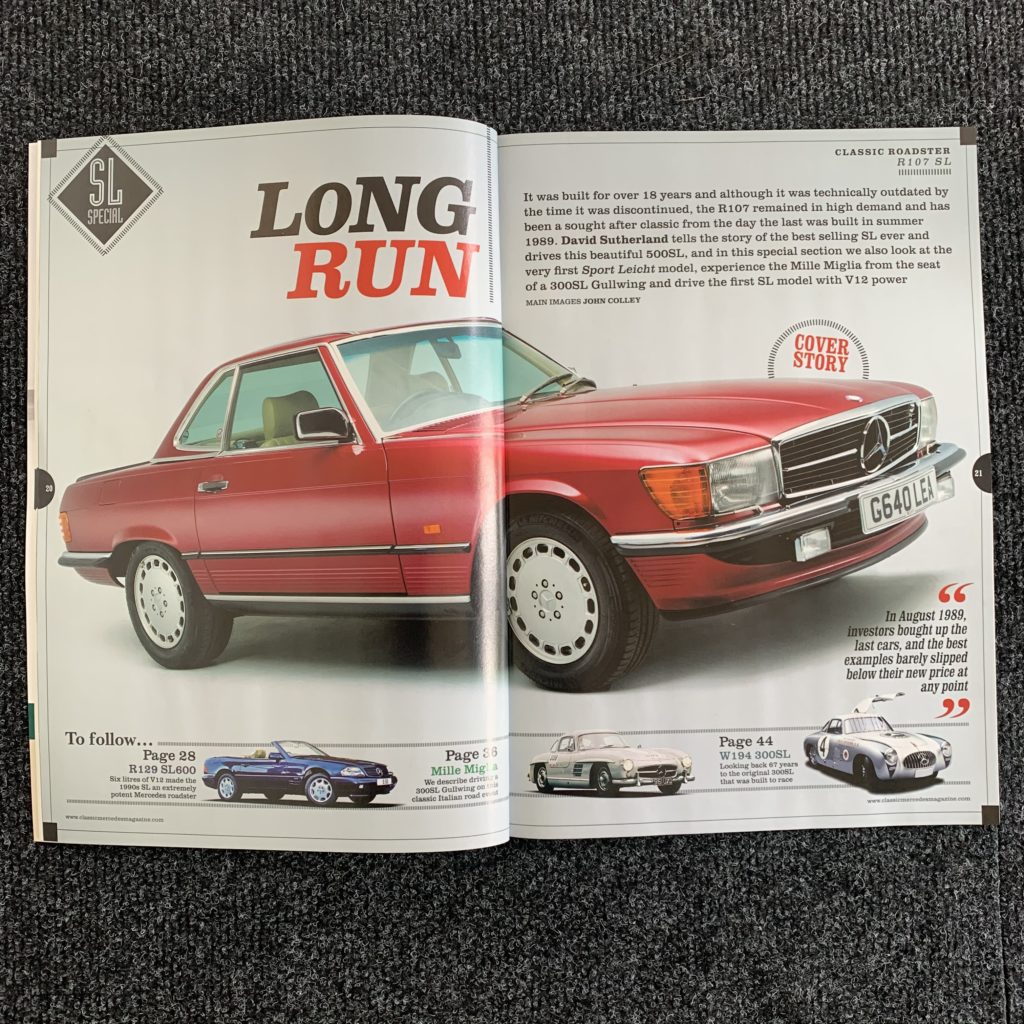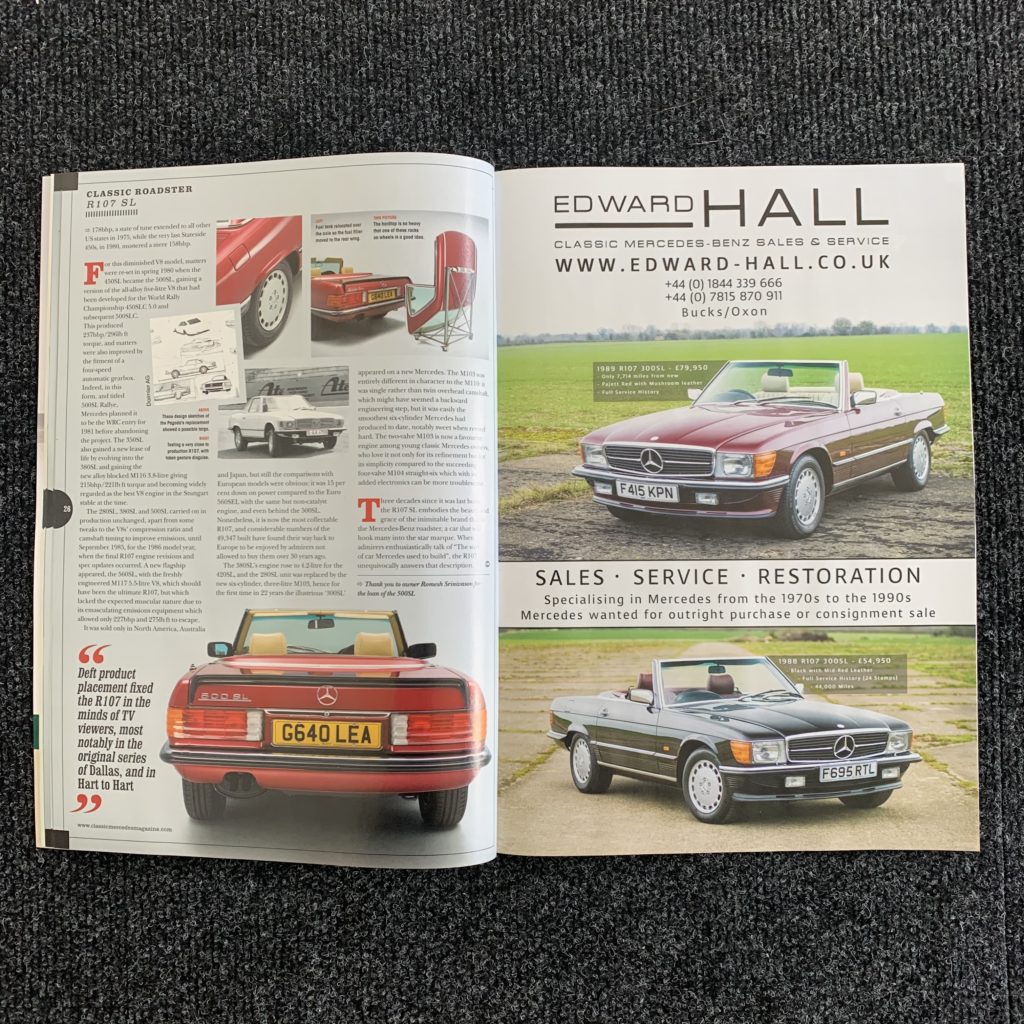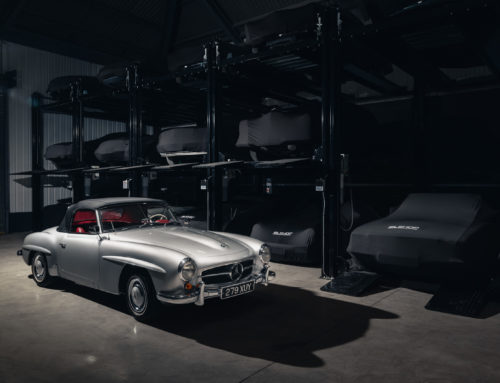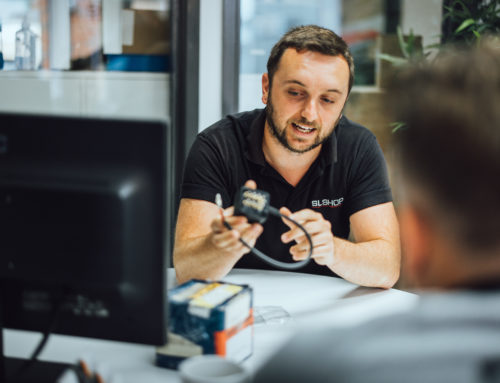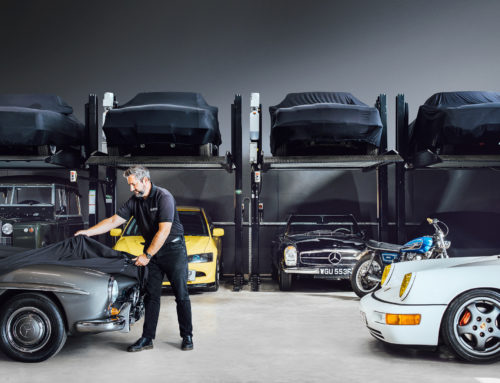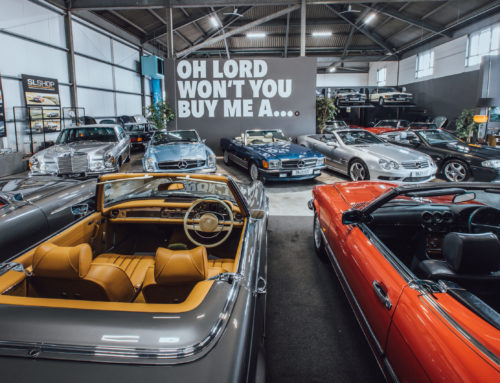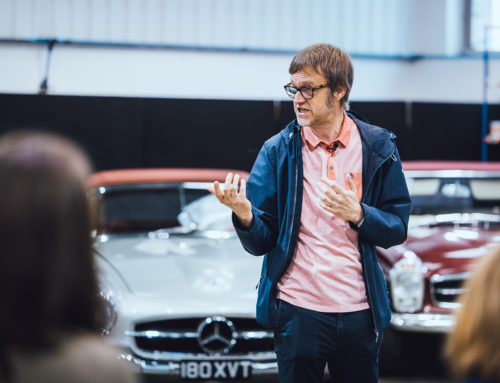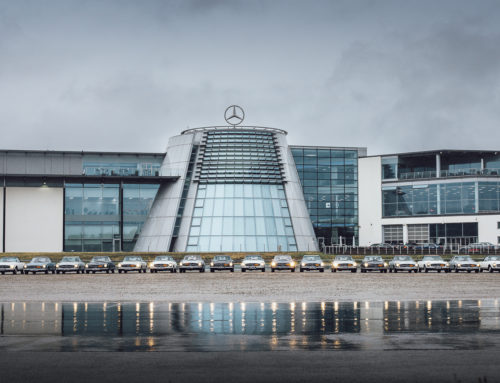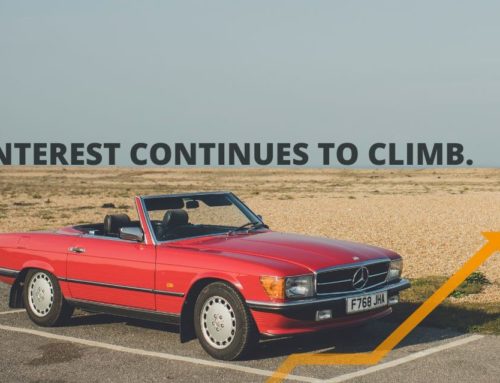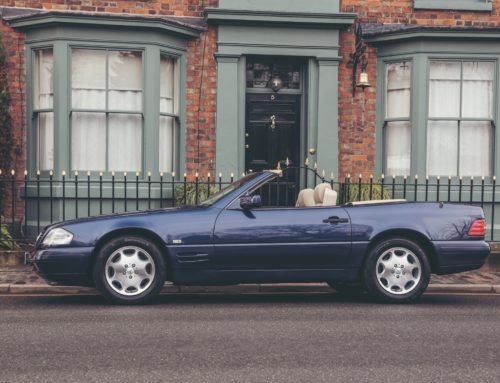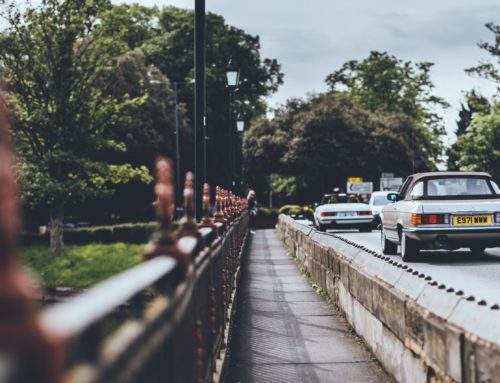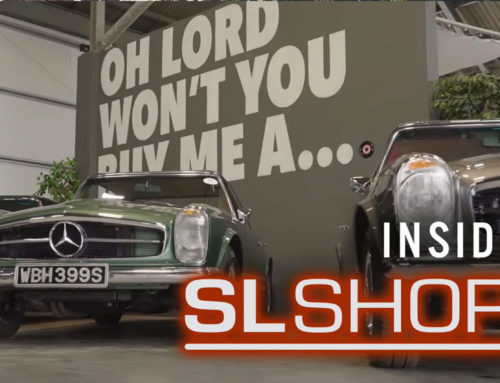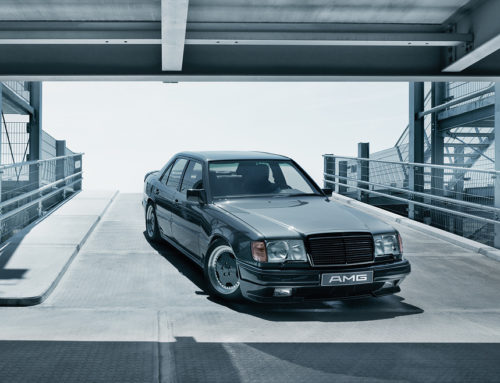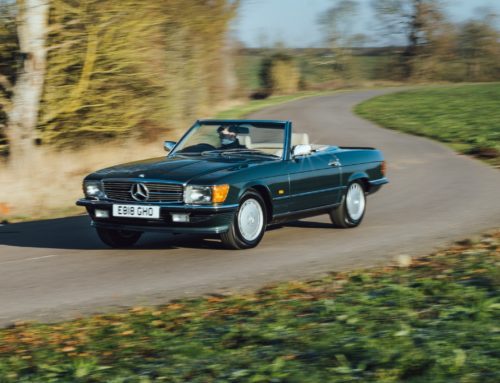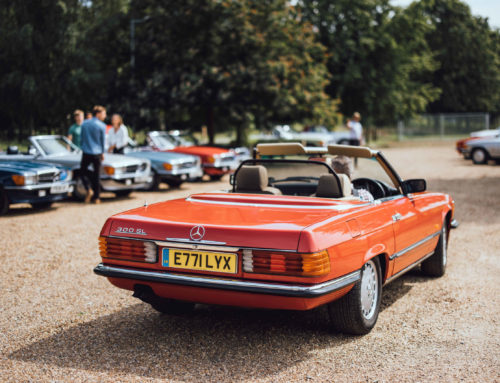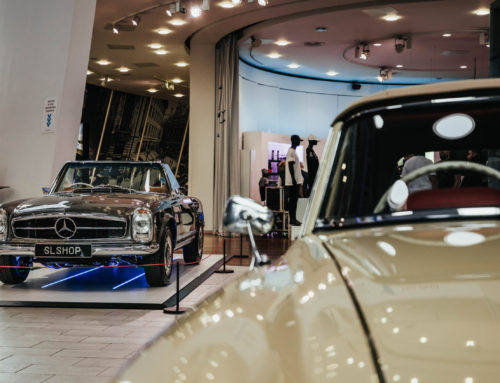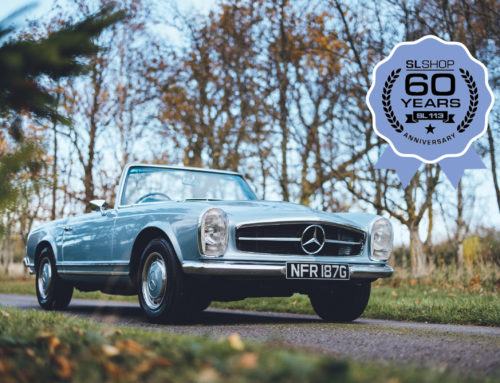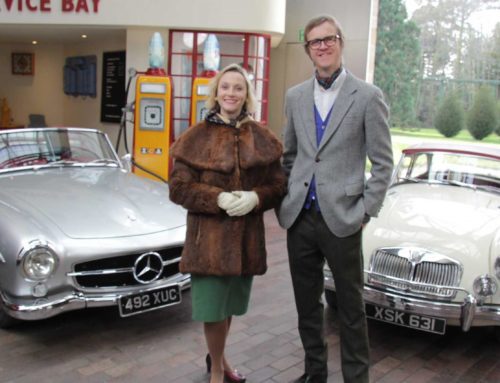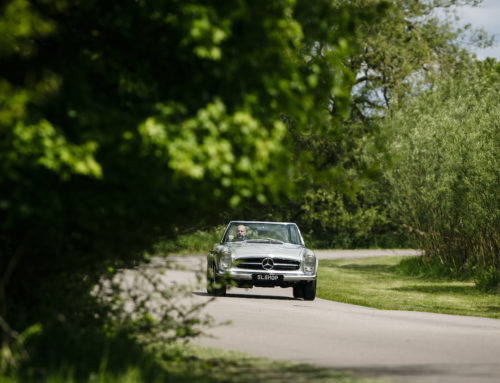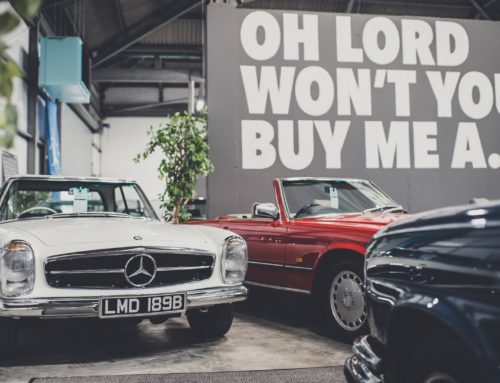It was built for over 18 yeas and although it was technically outdated by the time it was discontinued, the R107 remained in high demand and has been a sought-after classic from the day the last was built in summer 1989. David Sutherland tells the story of the best-selling SL ever and drives this beautiful 500SL, and in this special section we also look at the very first Sport Leicht model, experience the Millie Miglia form the seat of a 300 SL Gullwing and drive the first SL model with V12 power.
Classic Roadster
R107 SL
For Mercedes-Benz the R107SL is the gift that keeps on giving. Launched in spring 1971, it commanded a full order book for 18 years and four months, three times longer than the average production cycles of the previous four SL generations; 237,287 were built, again some three times the combined total of the others.
And when it was finally discontinued, in August 1989, investors bought up the last cars and well-preserved examples have barely slipped below their new price at any point. And now, those late cars with delivery mileage that investors snapped up 31 years ago are again working for Mercedes-Benz, underpinning its heritage with six-figure values in some cases.
Eighteen years was an uncommonly long time for any car to remain in production, especially one from a resource rich manufacturer committed to constantly investing in new product and technology to keep ahead of the game. When it bowed out, the only other volume-made passenger cars that had been around for longer were relic from a past motoring era, the Mini and the Citroen 2CV.
The R107’s desirability glows ever brighter as the years pass, and it has reached the point where a specialist, such as Stratford-upon-Avon based SL Shop, which kindly arranged for the loan of the 500SL photographed here, can now find a business case in R107 SL restoration. The model’s appeal has even negatively impacted its R129 successor, which although a technically superior car in every way has so far struggled to win over collectors in the same way. So, what was its secret?
It was the right car for its time, an era when customers, especially in the US, were seeking every more luxury. The W113 SL ‘Pagoda” had served Mercedes well, but for all its still stunning looks it belonged to the 1960s. Mainstream customers were becoming less tolerant of sports car compromises and, this still (just) being the era of cheap petrol, wanted V8 engines, the bigger the better.
Although the R107 was only slightly larger than the Pagoda 60mm more in the wheelbase,105mm in overall length, and 30mm wider – its relaxed elegance, in contrast to the early 1960s, almost Italianate sharpness of the pagoda, gave it a more ‘grown up’ look, right on the wavelength of wealthy middle America. Its increased presence also allowed it to serve, in fixed-head C107 SLC form, as the replacement for the W111 couple.
In the post-Ralph Nader safety era, the R107s’s various safety measures appealed, too, making those on the Pagoda seem almost token gestures. For example, the fuel tank was moved from below the boot floor to a considerably less vulnerable position over the rear axle, and there were far fewer sharp switches and other protrusions on the fascia while the front, A-pillars had deflectors to channel rain off and aid driver visibility, and large tail light lenses with a ribbed surface enhanced lighting brightness.
The move away from the rear swing-axle used in all previous SLs and indeed all Mercedes’ post-war cars up until the 1968 W114/W115 might also have been considered a safety advance. As had the ‘Stroke 8’, the R107 adopted an independently sprung semi-trailing set up, offering improved on-the-limit stability due to reduced camber change.
Mercedes’ test engineer Erich Waxenberger’s mid 1960s failure to make the Pagoda a workable V8 saw the W113 capped at 2.8 litres but from the start, eight was the only number of cylinders on view in an R107 engine bay. For Europe this was the M116 3.5-litre, producing 197bhp and 211lb ft torque, from the W108 saloon and W111 coupe and convertible, but American-market 350SLs used a 4.5-litre V8 restricted to 192bhp; after two years European markets got the bigger engine, in freer breathing 222bhp/278lb ft form, and the ‘450SL badge was applied to the US model.
The Middle East war in 1973 precipitated a so-called fuel crisis and multiplying pump prices, forcing Mercedes-Benz for the first time to be seen to be energy conscious. The car maker’s reaction was to install its recently introduced 2.7-litre M110 six-cylinder engine into the R107, badging it the 280SL (an equivalent 280SLC appeared, too).
Judged purely as an ‘economy’ car it made little sense, the quoted fuel consumption of 22.6mpg bettering the 350SLs by less than 1mpg. But the new model not only highlighted Stuttgart’s willingness to engage with the environment but also opened up a new if perhaps unexpected role for the R107, that of a more responsive and satisfying roadster, thanks to the revy M110 and four – rather than three – speed automatic gearbox. The 280SL sold reasonably well, finding 25,463 customers, although the majority of R107s were V8s, and throughout the 1970s the 450SL was the clear favourite, perfect too for a sun-soaked highway cruise. It wasn’t an American car, but was part of the American dream, especially as deft product placement fixed the R107 in the minds of TV viewers, most notably in the original series of Dallas, broadcast from 1978, and in Hart to Hart.
But those cruises would be unhurried, all the more so as the 1970s progressed due to falling output from the US spec 4.5-litre V8 as ever tougher emissions regulations were met. By 1974 450SLs sold in California had dropped to 178bhp, a state of tune extended to all other US states in 1975, while the very last Stateside 450s, in 1980, mustered a mere 158bhp.
For this diminished V8 model, matters were re-set in spring 1980 when the 450SL became the 500SL, gaining a version of the all-alloy five-litre V8 that had been developed for the World Rally Championship 450SLC 5.0 and subsequent 500SLC. This produced 237bhp/296lb ft torque, and matters were also improved by the fitment of a four-speed automatic gearbox. Indeed, in this form, and titled 500SL, Rally Mercedes planned it to be the WRC entry for 1981 before abandoning the project. The 350SL also gained a new lease of life by evolving into the 380SL and gaining the new alloy blocked M116 3.8-litre giving 215bhp/22llb ft torque and becoming widely regarded as the best V8 engine in the Stuttgart stable at the time.
The 280SL, 380SL and 500SL carried on in production unchanged, apart from some tweaks to the V8’s compression ratio and camshaft timing to improve emissions, until September 1985, for the 1986 model year, when the final R107 engine revisions and spec updates occurred. A new flagship appeared, the 560SL, with the freshly engineered M117 5.5-litre V8, which should have been the ultimate R107, but which lacked the expected muscular nature due to its emasculating emissions equipment which allowed only 227bhp and 275lb ft to escape.
It was sold only in North America, Australia, and Japan, but still the comparisons with European models were obvious: it was 15 per cent down on power compared to the Euro 560SEL with the same but non-catalyst engine, and even behind the 500SL. Nonetheless, it is now the most collectable R107, and considerable numbers of the 49,347 built have found their way back to Europe to be enjoyed by admirers not allowed to buy them over 30 years ago.
The 380LL’s engine rose to 4.2-litre for the 420SL, and the 280SL unit was replaced by the new six-cylinder, three-litre M103, hence for the first time in 22 years the illustrious ‘300SL’ appeared on a new Mercedes. The M103 was entirely different in character to the M110: it was single rather than twin overhead camshaft, which might have seemed a backward engineering step but it was easily the smoothest six-cylinder Mercedes had produced to date, notably sweet when revved hard. The two-valve M103 is now a favourite engine among young classic Mercedes owners, who love it not only for its refinement but for its simplicity compared to the succeeding four-valve M104 straight-six which with its added electronics can be more troublesome.
Three decades since it was last built, the R107SL embodies the beauty and grace of the inimitable brand that is the Mercedes-Benz roadster, a car that will hook many into the star marque. When admirers enthusiastically talk of ‘The sort of car Mercedes used to build”, the R107 unequivocally answers that description.
R107 Restoration
You can still buy them cheaply, but whether an R107 can now sell for £100,000, it’s still possible to find one under £15,000 (or even for less than £10,000 if you look hard). So, does it make sense to buy cheap and restore?
“It depends on the level of restoration the customer requires,” says SL Shop’s Bruce Greetham. “A full body-off restoration can cost £100,000, and it can go to more than £150,000 if we are talking about a V8 500SL that’s fully optioned including air-conditioning, given its added complexity.”
The biggest single issue on an R107 tends to be the bulkhead between the cabin and the engine bay, unseen but which is almost always rust, sometimes beyond repair. SL Shop has devised its own solution, a replacement bulkhead, that unlike h the original, is galvanised.
Other metalwork repairs are almost certain to be required. “We’ll probably need to fabricate with new metal the front and back chassis legs, the inner and outer sills, the floorpans and the boot corners,” Bruce advises. “Even the later cars suffer if they’ve been left outside for many years.”
With the classic market now valuing originality much more than in previous times, retaining the original interior trim, and its irreplaceable patina, is the preferred route for many customers. But if trim is too deteriorated to revive, replacement leather, vinyl or cloth must be fitted, and the best restorations will feature genuine materials, which Bruce says can still be obtained from German producers.
Customers should also accept that a full restoration is best seen as a long-term investment. While the R107 is currently rising in value, even the top prices realised will barely recoup the bill for restoration work done.
Driving the 500SL
With minimal mileage, this late model R107 feels like new
There is a look and feel about a new car that even an old one restored on an unlimited budget cannot hope to offer. Everything about the genuinely new car, inside and out, has a sharpness about it and there is a unique smell – and despite this 500SL being built almost 30 years ago it absolutely has that aura. But then when we took to the wheel, it had covered just 4,854 miles since new.
The Amondine Red paintwork has a deep sheen, and the Mushroom leather upholstery is unmarked, gorgeous to the touch, and the springs below firm enough to evoke that feeling of austere luxury unique to Mercedes. The dark, polished wood on the centre console has a high shine and no scuffs or cracks, and the seat adjustment is stiff, probably because the seat has been moved so rarely. When we lowered the hood – a lever, given the welcome absence of retaining poppers and studs – we could feel the still slightly stiff canvas resisting being folded.
The debate about whether the six-cylinder 300SL or one of the V8s makes the best R107 is ongoing. But today, behind the wheel of this virgin 500SL, there is no contest for me; big cubes rule. In perfect tune, the M117 instantly hums into life and delivers linear torque from low revs, the single cam per bank, two-valvers as sweet as you could wish. Indeed, the five-litre is the best of the V8s; while the 5.5 M117 in the 560SL has more kudos, this is a little smoother and, in Euro specification, more powerful.
The way to enjoy a 450SL is to waft along at a relaxed pace, because no R107 is comfortable if pressed into corners, the recirculating ball steering uncommunicative, and the suspension allowing a lot of roll. And an R107 is two different cars depending on where the roof is. With the hood erected, and even more so with the metal hardtop in place, the cabin is cosy, but a tight fit, with headroom limited (the big steering wheel also requires you to carefully slide your leg under it when entering or existing the car). But once the canvas is folded and stowed under its metal cover there is a wonderful feeling of openness and freedom.
This 500SL is one of the every last built, registered in the UK on September 1, 1989. Then, the list price was £41,700, the leather, rear seat and outside temperature gauge adding £1,612 and the dealer-fitted Blaupunkt Melbourne SQR 39 radio/cassette an additional amount. It was part of a collection, and, ironically, one of the reasons for its recent sale was that with under 10,000 miles it was not eligible for the concours at Mercedes-Benz Club events.
Not unreasonably, I was asked to keep my drive brief, the owner not wishing the mileage to tip over 5,000. I returned with 4,870 miles, wondering how many more lucky people, if any, will get to repeat my 16 glorious miles one of the best T107 500SLs in the world.
It was built for over 18 yeas and although it was technically outdated by the time it was discontinued, the R107 remained in high demand and has been a sought-after classic from the day the last was built in summer 1989. David Sutherland tells the story of the best-selling SL ever and drives this beautiful 500SL, and in this special section we also look at the very first Sport Leicht model, experience the Millie Miglia form the seat of a 300 SL Gullwing and drive the first SL model with V12 power.
Classic Roadster
R107 SL
For Mercedes-Benz the R107SL is the gift that keeps on giving. Launched in spring 1971, it commanded a full order book for 18 years and four months, three times longer than the average production cycles of the previous four SL generations; 237,287 were built, again some three times the combined total of the others.
And when it was finally discontinued, in August 1989, investors bought up the last cars and well-preserved examples have barely slipped below their new price at any point. And now, those late cars with delivery mileage that investors snapped up 31 years ago are again working for Mercedes-Benz, underpinning its heritage with six-figure values in some cases.
Eighteen years was an uncommonly long time for any car to remain in production, especially one from a resource rich manufacturer committed to constantly investing in new product and technology to keep ahead of the game. When it bowed out, the only other volume-made passenger cars that had been around for longer were relic from a past motoring era, the Mini and the Citroen 2CV.
The R107’s desirability glows ever brighter as the years pass, and it has reached the point where a specialist, such as Stratford-upon-Avon based SL Shop, which kindly arranged for the loan of the 500SL photographed here, can now find a business case in R107 SL restoration. The model’s appeal has even negatively impacted its R129 successor, which although a technically superior car in every way has so far struggled to win over collectors in the same way. So, what was its secret?
It was the right car for its time, an era when customers, especially in the US, were seeking every more luxury. The W113 SL ‘Pagoda” had served Mercedes well, but for all its still stunning looks it belonged to the 1960s. Mainstream customers were becoming less tolerant of sports car compromises and, this still (just) being the era of cheap petrol, wanted V8 engines, the bigger the better.
Although the R107 was only slightly larger than the Pagoda 60mm more in the wheelbase,105mm in overall length, and 30mm wider – its relaxed elegance, in contrast to the early 1960s, almost Italianate sharpness of the pagoda, gave it a more ‘grown up’ look, right on the wavelength of wealthy middle America. Its increased presence also allowed it to serve, in fixed-head C107 SLC form, as the replacement for the W111 couple.
In the post-Ralph Nader safety era, the R107s’s various safety measures appealed, too, making those on the Pagoda seem almost token gestures. For example, the fuel tank was moved from below the boot floor to a considerably less vulnerable position over the rear axle, and there were far fewer sharp switches and other protrusions on the fascia while the front, A-pillars had deflectors to channel rain off and aid driver visibility, and large tail light lenses with a ribbed surface enhanced lighting brightness.
The move away from the rear swing-axle used in all previous SLs and indeed all Mercedes’ post-war cars up until the 1968 W114/W115 might also have been considered a safety advance. As had the ‘Stroke 8’, the R107 adopted an independently sprung semi-trailing set up, offering improved on-the-limit stability due to reduced camber change.
Mercedes’ test engineer Erich Waxenberger’s mid 1960s failure to make the Pagoda a workable V8 saw the W113 capped at 2.8 litres but from the start, eight was the only number of cylinders on view in an R107 engine bay. For Europe this was the M116 3.5-litre, producing 197bhp and 211lb ft torque, from the W108 saloon and W111 coupe and convertible, but American-market 350SLs used a 4.5-litre V8 restricted to 192bhp; after two years European markets got the bigger engine, in freer breathing 222bhp/278lb ft form, and the ‘450SL badge was applied to the US model.
The Middle East war in 1973 precipitated a so-called fuel crisis and multiplying pump prices, forcing Mercedes-Benz for the first time to be seen to be energy conscious. The car maker’s reaction was to install its recently introduced 2.7-litre M110 six-cylinder engine into the R107, badging it the 280SL (an equivalent 280SLC appeared, too).
Judged purely as an ‘economy’ car it made little sense, the quoted fuel consumption of 22.6mpg bettering the 350SLs by less than 1mpg. But the new model not only highlighted Stuttgart’s willingness to engage with the environment but also opened up a new if perhaps unexpected role for the R107, that of a more responsive and satisfying roadster, thanks to the revy M110 and four – rather than three – speed automatic gearbox. The 280SL sold reasonably well, finding 25,463 customers, although the majority of R107s were V8s, and throughout the 1970s the 450SL was the clear favourite, perfect too for a sun-soaked highway cruise. It wasn’t an American car, but was part of the American dream, especially as deft product placement fixed the R107 in the minds of TV viewers, most notably in the original series of Dallas, broadcast from 1978, and in Hart to Hart.
But those cruises would be unhurried, all the more so as the 1970s progressed due to falling output from the US spec 4.5-litre V8 as ever tougher emissions regulations were met. By 1974 450SLs sold in California had dropped to 178bhp, a state of tune extended to all other US states in 1975, while the very last Stateside 450s, in 1980, mustered a mere 158bhp.
For this diminished V8 model, matters were re-set in spring 1980 when the 450SL became the 500SL, gaining a version of the all-alloy five-litre V8 that had been developed for the World Rally Championship 450SLC 5.0 and subsequent 500SLC. This produced 237bhp/296lb ft torque, and matters were also improved by the fitment of a four-speed automatic gearbox. Indeed, in this form, and titled 500SL, Rally Mercedes planned it to be the WRC entry for 1981 before abandoning the project. The 350SL also gained a new lease of life by evolving into the 380SL and gaining the new alloy blocked M116 3.8-litre giving 215bhp/22llb ft torque and becoming widely regarded as the best V8 engine in the Stuttgart stable at the time.
The 280SL, 380SL and 500SL carried on in production unchanged, apart from some tweaks to the V8’s compression ratio and camshaft timing to improve emissions, until September 1985, for the 1986 model year, when the final R107 engine revisions and spec updates occurred. A new flagship appeared, the 560SL, with the freshly engineered M117 5.5-litre V8, which should have been the ultimate R107, but which lacked the expected muscular nature due to its emasculating emissions equipment which allowed only 227bhp and 275lb ft to escape.
It was sold only in North America, Australia, and Japan, but still the comparisons with European models were obvious: it was 15 per cent down on power compared to the Euro 560SEL with the same but non-catalyst engine, and even behind the 500SL. Nonetheless, it is now the most collectable R107, and considerable numbers of the 49,347 built have found their way back to Europe to be enjoyed by admirers not allowed to buy them over 30 years ago.
The 380LL’s engine rose to 4.2-litre for the 420SL, and the 280SL unit was replaced by the new six-cylinder, three-litre M103, hence for the first time in 22 years the illustrious ‘300SL’ appeared on a new Mercedes. The M103 was entirely different in character to the M110: it was single rather than twin overhead camshaft, which might have seemed a backward engineering step but it was easily the smoothest six-cylinder Mercedes had produced to date, notably sweet when revved hard. The two-valve M103 is now a favourite engine among young classic Mercedes owners, who love it not only for its refinement but for its simplicity compared to the succeeding four-valve M104 straight-six which with its added electronics can be more troublesome.
Three decades since it was last built, the R107SL embodies the beauty and grace of the inimitable brand that is the Mercedes-Benz roadster, a car that will hook many into the star marque. When admirers enthusiastically talk of ‘The sort of car Mercedes used to build”, the R107 unequivocally answers that description.
R107 Restoration
You can still buy them cheaply, but whether an R107 can now sell for £100,000, it’s still possible to find one under £15,000 (or even for less than £10,000 if you look hard). So, does it make sense to buy cheap and restore?
“It depends on the level of restoration the customer requires,” says SL Shop’s Bruce Greetham. “A full body-off restoration can cost £100,000, and it can go to more than £150,000 if we are talking about a V8 500SL that’s fully optioned including air-conditioning, given its added complexity.”
The biggest single issue on an R107 tends to be the bulkhead between the cabin and the engine bay, unseen but which is almost always rust, sometimes beyond repair. SL Shop has devised its own solution, a replacement bulkhead, that unlike h the original, is galvanised.
Other metalwork repairs are almost certain to be required. “We’ll probably need to fabricate with new metal the front and back chassis legs, the inner and outer sills, the floorpans and the boot corners,” Bruce advises. “Even the later cars suffer if they’ve been left outside for many years.”
With the classic market now valuing originality much more than in previous times, retaining the original interior trim, and its irreplaceable patina, is the preferred route for many customers. But if trim is too deteriorated to revive, replacement leather, vinyl or cloth must be fitted, and the best restorations will feature genuine materials, which Bruce says can still be obtained from German producers.
Customers should also accept that a full restoration is best seen as a long-term investment. While the R107 is currently rising in value, even the top prices realised will barely recoup the bill for restoration work done.
Driving the 500SL
With minimal mileage, this late model R107 feels like new
There is a look and feel about a new car that even an old one restored on an unlimited budget cannot hope to offer. Everything about the genuinely new car, inside and out, has a sharpness about it and there is a unique smell – and despite this 500SL being built almost 30 years ago it absolutely has that aura. But then when we took to the wheel, it had covered just 4,854 miles since new.
The Amondine Red paintwork has a deep sheen, and the Mushroom leather upholstery is unmarked, gorgeous to the touch, and the springs below firm enough to evoke that feeling of austere luxury unique to Mercedes. The dark, polished wood on the centre console has a high shine and no scuffs or cracks, and the seat adjustment is stiff, probably because the seat has been moved so rarely. When we lowered the hood – a lever, given the welcome absence of retaining poppers and studs – we could feel the still slightly stiff canvas resisting being folded.
The debate about whether the six-cylinder 300SL or one of the V8s makes the best R107 is ongoing. But today, behind the wheel of this virgin 500SL, there is no contest for me; big cubes rule. In perfect tune, the M117 instantly hums into life and delivers linear torque from low revs, the single cam per bank, two-valvers as sweet as you could wish. Indeed, the five-litre is the best of the V8s; while the 5.5 M117 in the 560SL has more kudos, this is a little smoother and, in Euro specification, more powerful.
The way to enjoy a 450SL is to waft along at a relaxed pace, because no R107 is comfortable if pressed into corners, the recirculating ball steering uncommunicative, and the suspension allowing a lot of roll. And an R107 is two different cars depending on where the roof is. With the hood erected, and even more so with the metal hardtop in place, the cabin is cosy, but a tight fit, with headroom limited (the big steering wheel also requires you to carefully slide your leg under it when entering or existing the car). But once the canvas is folded and stowed under its metal cover there is a wonderful feeling of openness and freedom.
This 500SL is one of the every last built, registered in the UK on September 1, 1989. Then, the list price was £41,700, the leather, rear seat and outside temperature gauge adding £1,612 and the dealer-fitted Blaupunkt Melbourne SQR 39 radio/cassette an additional amount. It was part of a collection, and, ironically, one of the reasons for its recent sale was that with under 10,000 miles it was not eligible for the concours at Mercedes-Benz Club events.
Not unreasonably, I was asked to keep my drive brief, the owner not wishing the mileage to tip over 5,000. I returned with 4,870 miles, wondering how many more lucky people, if any, will get to repeat my 16 glorious miles one of the best T107 500SLs in the world.
More from Journal
CARE
THE ULTIMATE CERTIFIED SERVICING INVESTMENT PLAN
Your ownership journey matters to us, which is why we have created a simple certified servicing investment plan, tailored to your individual needs and aspirations.
Start investing today and our dedicated CARE team will work with you to increase the value and enjoyment you receive from your vehicle.

STAY IN TUNE WITH SLSHOP MOMENTS
As part of SLSHOP’s community of enthusiasts, you’ll be the first to hear about events and tours, key product offers, exciting stories from owners around the world and of course… our latest additions to the showroom. So, be the first to know and you might just sneak a car on your driveway or take your car’s condition to new heights with our exclusive replacement parts.
Or, visit SLSHOP Journal

